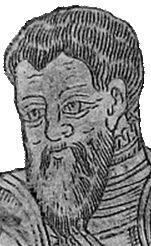Name Richard Fortescue | Died 1570 | |
 | ||
Richard Fortescue (c. 1517–1570) of Filleigh, North Devon was an English Member of Parliament and prominent land-owner and member of the Devonshire gentry, ancestor to the Earls Fortescue.
Contents
- Origins
- Career
- Marriage and Progeny
- Death and burial
- Monumental brasses
- Brass of Richard Fortescue
- Brass of Sir Bernard Drake
- References
Origins
The Fortescues are an ancient family, whose roots can be traced back to Norman times. He was the eldest son of Bartholomew Fortescue, Esq. (d. 1557), lord of the manor of Filleigh and of several other manors, by his wife Ellen More (or Moore), daughter of Maurice More of Moor Hayes in Cullompton, Devon. He was a great-grandson of Sir John Fortescue (c. 1394 - c. 1480), chief justice.
Career
Richard Fortescue was elected MP for Tavistock in 1545. He was a Justice of the Peace for Devon by 1558/9, and Sheriff of Devon in 1562-3.
Marriage and Progeny
He married about 1544 Joan Morton, daughter of Robert Morton, by Dorothy, daughter of Sir John Fitz James, of Redlynch (in Bruton), Somerset, Chief Baron of the Exchequer, Chief Justice of the King’s Bench, 1526–39 [see Benolte et al., Vis. of Somerset 1531, 1573 & 1591 (1885): 24, 106; Hunter, Familiæ Minorum Gentium 1 (H.S.P. 37) (1894): 241–244 (Morton ped.); Foss, Judges of England 5 (1857): 170–181 (biog. of John Fitz-James)]. They had at least one son, and two daughters, including:
Death and burial
He died on 30 June 1570 at Filleigh, and was buried in Filleigh Church, where two monumental brasses exist in his memory.
Monumental brasses
Two monumental brasses which formerly adorned a tomb-monument of Richard Fortescue exist in Filleigh Church, having been removed from their original setting in the old parish church of Filleigh, demolished c. 1730 to make way for landscaping surrounding the Palladian mansion of Castle Hill, which was a re-modelling of Richard Fortescue's ancient manor house. Both are now affixed within Victorian wooden frames on the north wall of the nave of the new parish church of St Paul, built in 1732 some half mile away from its former location next to the manor house. There are two heraldic escutcheons on each brass, in poor condition with parts torn away.
Brass of Richard Fortescue
The right-hand (easternmost) brass on the nave wall depicts Richard Fortescue as a heavily bearded figure dressed in armour kneeling towards the left at a prie-dieu, with his helmet and gauntlets on the floor. It is inscribed below in Gothic script:
"Here lyeth Richard Ffortescue of Ffylleygh, Esquier, who dyed on the last daye of June in the yere of oure lorde god 1570"
On either side are two escutcheons. That on the dexter shows the arms of Fortescue in the first quarter with three other quarterings. The escutcheon is surmounted by a crest, apparently a plain shield, in Latin scutum, alluding to the Latinized family name de Forti Scuto meaning "(from) a strong shield". In the 2nd quarter are the arms of Denzil (or Denshill): Sable a crescent with a mullet issuing from between its horns argent [see Sir George Carew's Scroll of Arms 1588 (1901): 93]. The arms in the 3rd quarter are the arms of Filleigh: Gules, a fess vairee between 6 crosses formee or. In the 4th quarter are the arms of Walter Treawyn of Weare Gifford, (d. 1381) by marriage to whose daughter and heiress, according to Tristram Risdon, the Fortescues had acquired Weare Giffard: Argent, on a bend vert between six crosses crosslet fitchee gules three crozier heads or.
The shield to the sinister shows Fortescue, with quarterings as at dexter, impaling Morton: Quarterly, 1st and 4th: Gules, a goat's head erased or; 2nd and 3rd: Ermine, (Moreton). These are the arms of his wife's family. They are the same arms borne by Joan Morton's kinsman, John Morton (c. 1420 – 15 September 1500), Archbishop of Canterbury 1486 to 1500. The heraldic overmantel now at Simonsbath House originally from Weare Giffard Hall, both former Fortescue residences, appears to confirm the blazon. A framed handwritten note, c. 1900, made by a member of the Fortescue family hangs by the side of the Simonsbath House overmantel and states the arms to be of Morton.
Brass of Sir Bernard Drake
The other brass on the left (westernmost) depicts his brother-in-law Sir Bernard Drake (d. 1586), of Ash, near Musbury, who erected the monument, kneeling towards the right, in a similar posture in similar dress. Sir Bernard Drake had married Gertrude Fortescue (d. 1601), Richard's sister, as his monument in Musbury Church in Devon records. The inscription below in Gothic lettering of exactly the same style as the other brass reads:
"Forget who can yf that he lyft to see,
Fortescue of ffylleghie the seventhe of that degre,
Remembrance of a frynde his brother Drake doth showe,
Presentinge this unto the eyes of moo, (more)
Hurtfull to none and fryndlye to the moste,
The erthe his bones the heavens possese his goste.
The last line of poetry is taken from the last line of the work of Henry Howard, Earl of Surrey (d. 1547) "On Sir Thomas Wyatt". The escutcheon on the dexter shows the arms of Drake of Ash: A wyvern gules, badly mutilated. The escutcheon on the sinister side shows the arms of Drake's wife, Gertrude Fortescue, and its quarterings.
